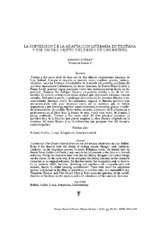La subversion de la adaptacion literaria en Tristana y ese oscuro objeto del deseo de Luis Buñuel
Autor
Duprat de Montero, Arnaud
Editor
UCOPressFecha
2012Materia
Buñuel, Luis, 1900-1983Pérez Galdós, Benito, 1843-1920
Louys, Pierre, 1870-1925
Adaptación
Intertextualidad
Adaptation
Intertextuality
METS:
Mostrar el registro METSPREMIS:
Mostrar el registro PREMISMetadatos
Mostrar el registro completo del ítemResumen
Tristana y Ese oscuro objeto del deseo son las dos últimas adaptaciones literarias de Luis Buñuel. Aunque el cineasta se permita varios cambios –cortes, síntesis, añadidos– en estas historias al trasladarlas de la novela a la pantalla, produciendo así obras típicamente buñuelianas, los textos literarios de Benito Pérez Galdós y Pierre Louÿs parecen seguir presentes como una referencia reivindicada en las películas. Primero, los diálogos fílmicos se parecen mucho a los de las dos novelas. Se nota lo novelesco en varias réplicas que, demasiado literarias, suenan extrañas. Del mismo modo, si podemos reconocer en las heroínas fílmicas a sus antecedentes literarios como una referencia original, el director provoca este reconocimiento sólo para atraernos mejor en un universo que se vuelve inquietante y que interroga nuestras representaciones y creencias, gracias a sutiles desplazamientos de sentido. Estos textos resisten al proceso de la adaptación y permanecen en el filme bajo la forma de citas, como otro texto, de manera a priori inalterada. Tristana y Ese oscuro objeto del deseo plantean entonces la problemática de la función que puede asegurar la obra literaria adaptada en la escritura del texto fílmico y en la subversión que propone éste del discurso cinematográfico. Tristana and That Obscure Object of Desire are the last literary adaptations by Luis Buñuel. Even if the director takes the liberty of making various changes –cuts, synthesis, additions– in the adaptation process, to create Buñuelian works, the literary texts by Benito Pérez Galdós and Pierre Louÿs seem to be still presents in the films as a claimed reference. Firstly, the cinematic lines look like the literary dialogues and sound strange on the screen. In the same way, if we recognize the literary heroines in the cinematic characters as an original reference, the director creates this recognition only to draw us to an universe which becomes disturbing and questions our comprehension and believes, thanks to skilful meaning modifications. These texts resist the adaptation process and remain in the films as quotations, as another texts, in a unmodified way. Therefore Tristana and That Obscure Object of Desire pose the question of the novel’s function in the filmic work’s creation and in its subversion of the cinematic discourse.

